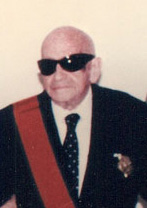Memories of Henri Pharaon
The previous post triggered some memories, which I am eager to put in writing so they don’t vanish — especially as my father, now 86, cannot be persuaded to write his memoirs.
Starting from the mid-1980s, my father, General Salim Al-Dahdah, would regularly take me with him to the Beirut racetrack, l’Hippodrome du Parc de Beyrouth. He was a longstanding member of the board of the racetrack’s supervising organization, the Societe pour la Protection et l’Amelioration de la Race Chevaline Arabe au Liban (SPARCA).
Henri Pharaon had founded SPARCA in the 1920s and had led it most of his life. He also owned the largest number of racehorses at any given point in the racetrack’s history. Other notable SPARCA members and large owners included Moussa de Freige and Saudi Royal Prince Mansur ibn Saud.
I only have faint memories of my earliest visits to the racing stables of Henri Pharaon and Moussa de Freige in the mid 1980s. These involve prancing horses, slender grooms, heaps of alfalfa, white plastic chairs, tea cups and endless conversations between adults, with their dose of foul language. They also involve sounds of neighing, horse farts, horses nervously pounding the metal doors of their boxes with their heels and the delicious smell of horse manure. They also involve my father’s car speeding to avoid snipers, before entering the racetrack premises from a backdoor entrance. This small entrance lied in the Christian part of the town, and led straight to Henri Pharaon’s stables. The more stately main entrance gate was in the Muslim part of the town, and was not accessible to us. The racetrack lied right on the no mans land between the two parts. I was seven years old in 1985.
I also recall a visit with my father to Henri Pharaon’s splendid palace, now a museum, which lied not far from Beirut’s no mans land. I must have have been about five or six. I remember being impressed by several Dobermans in large green cages, and smaller grey dogs too. I remember very high ceilings in the hallway after the main entrance, and some antiquities on both sides of the hallway. Above all, I remember an elegant black man opening the door. That was probably the first black person I had ever met.
My memories from the 1990s are much clearer. By 1991, peace was back and the city was unified again. Henri Pharaon, then aged ninety, crippled and blind, did not own horses anymore. He still attended the races every Sunday and was SPARCA’s honorary president. The board of SPARCA would meet each Sunday before the races. These meetings sometimes lasted two hours or more. I waited patiently in the room adjacent to the board room, on hard brown Chesterfield leather couches. Henri Pharaon was the only other person in the room. The teenager I was never dared to initiate a conversation with him. Sometimes, despite his blindness, he would quickly become aware of my presence in the room, and upon telling him I was his friend’s son, a conversation would ensue. He was profoundly attached to my father, and the respect and admiration were mutual. They had met in 1979, become fast friends, and visited frequently. They gifted each other many horses over the years: Farhan, Ghazwan III, and the now famous Nawaqiat ‘Akkar. There is a story behind each one of these gifts. His assassination in 1993 profoundly saddened my father. He and his driver were stabbed over 20 times, and the crime remains unsolved.
Here are two photos of Henri Pharaon for you: one in his youth, and another as I knew him in his last years, with the huge black glasses.


Edouard: Was Pharaon influential in helping with the 1947 Hearst importation? Plus I don’t understand all of the political assassinations. Gandi was right, an eye for an eye makes the whole world blind!
best
Bruce Peek
Bruce: The Hearst importation consisted entirely of horses from Henri Pharaon. He sold them to Preston Dyer, who was acting on behalf of WR Hearst.
So the Hearst horses would have had authentic provenance, to the point of Hujas, knowledge of which marbat they were out of, and of course their Bedouin breeders identity?
best
Bruce Peek
Bruce, there are quite a few posts on the Hearst horses on this blog, where Edouard has done some fantastic sleuth work on their origins, connecting them to their various marabet. You can pull them up by searching for “Hearst”.
Edouard, thank you for sharing these memories. It would be lovely to learn the stories behind the horses your father and Henri Pharaon gifted each other.
Really he was Biggest supporter for arabian horse races.
Bruce, Edouard wrote a wonderful article about the background of the Hearst desert-bred Arabians, part of the cover article on the April 2016 Arabian Horse World. Well worth getting as a back issue. I read it to Charles, toward the end of his life, and he loved it. Was probably the last thing he was able to focus on.
Pity there was little awareness of the importance of these horses until recently. We are lucky we managed to salvage the *Layya line, and missed the *Lebnanieh one by a couple years.
As fine – there is no other word for it- as fine as Zamals confirmation was its truly a pity that we don’t have Female line Muniqi’s of his quality that I know of available to us today. What saviours of the breed they would be.
best
Bruce Peek
Read the wikipedia link: it is accurate.
https://en.wikipedia.org/wiki/Henri_Philippe_Pharaoun
and the NYT article about his death
https://www.nytimes.com/1993/08/07/obituaries/henry-pharoun-is-slain-at-home-founder-of-free-lebanon-was-92.html